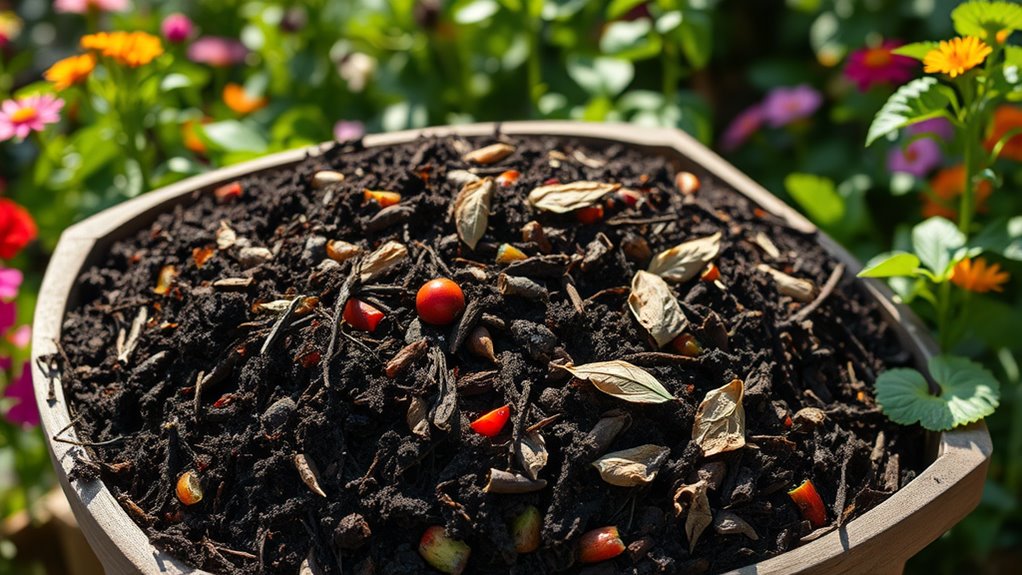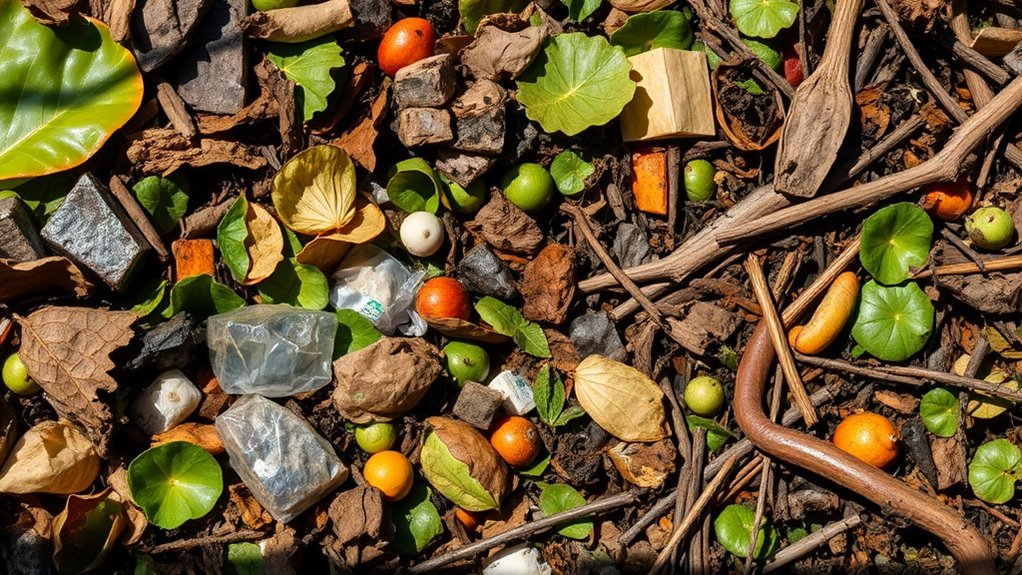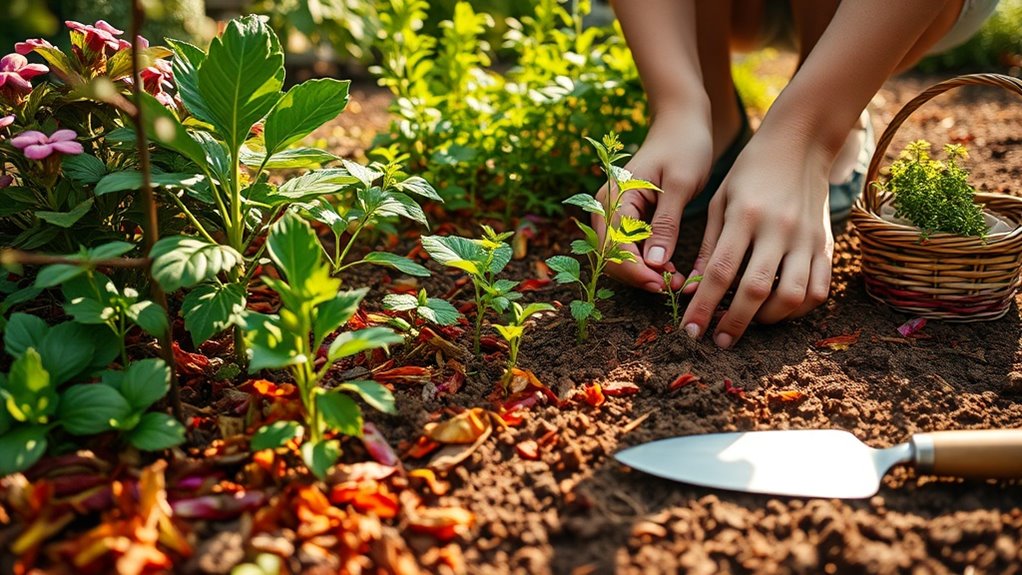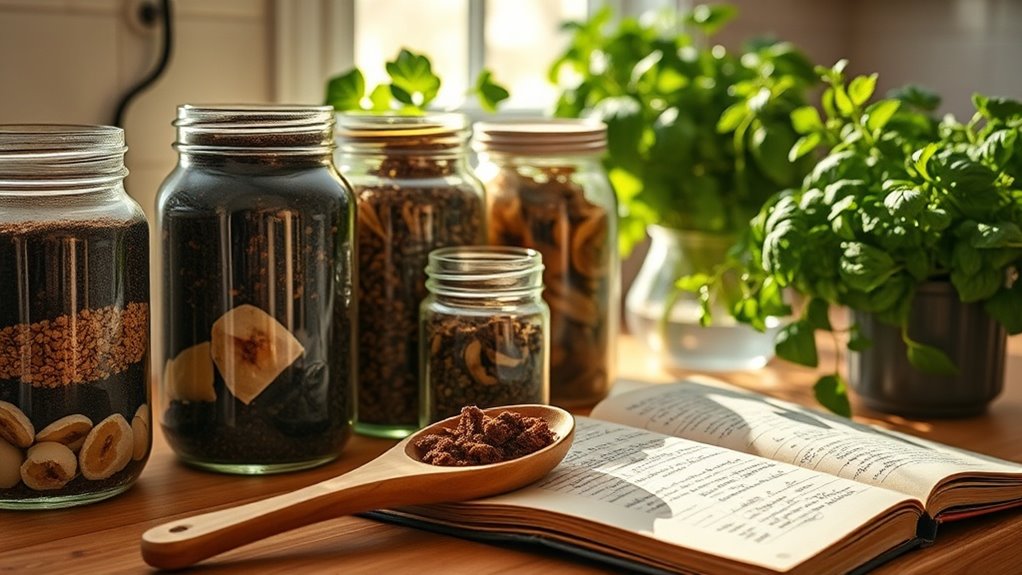Compost Without the Smell Using This Easy Method
Most people think composting inevitably leads to unpleasant odors, but that’s not the case. By understanding the balance of green and brown materials, along with proper aeration and moisture levels, you can create an efficient composting system that remains odor-free. This method not only keeps your compost pleasant but also enhances the quality of your garden. Discover how to optimize your composting strategy and enjoy the benefits without the smell.
Key Takeaways
- Balance green materials like kitchen scraps with brown materials such as dried leaves to prevent odors during composting.
- Aerate your compost regularly to enhance oxygen circulation and minimize anaerobic conditions that cause bad smells.
- Maintain moisture levels so compost feels like a damp sponge, adjusting with water if it’s too dry.
- Incorporate coarse materials like straw or wood chips to improve aeration and drainage, reducing odor development.
- Use an enclosed compost bin design to effectively manage odors during the decomposition process.
Understanding Composting Basics
Understanding the basics of composting is essential for anyone looking to create a sustainable and odor-free method of recycling organic waste.
Start by balancing green materials, like fruit scraps and grass clippings, with brown materials, such as leaves and cardboard. This balance ensures efficient decomposition and minimizes odors.
Aeration’s crucial, too; turning your compost regularly allows oxygen to circulate, preventing anaerobic conditions that lead to unpleasant smells.
Maintaining moisture without over-saturating is vital, as well. Additionally, proper aeration techniques can significantly enhance the composting process and reduce the chances of odor development.
Choosing the Right Composting Method
How do you decide which composting method suits your needs best?
First, consider your available space. If you’re limited, a compact bin or worm composting might be ideal.
Next, evaluate the amount of organic waste you generate; larger volumes may require a traditional compost pile.
Think about your time commitment too; methods like hot composting need more attention than passive systems.
Lastly, consider your climate, as it affects decomposition rates.
Each method has its advantages, so weigh your priorities—speed, convenience, or volume—before committing. By aligning your choice with your lifestyle, you’ll ensure a successful, odor-free composting experience. Additionally, the right composting method can help eliminate unpleasant odors and make the process more enjoyable.
Essential Materials for Odor-Free Compost
Choosing the right composting method sets the stage for successful composting, but the materials you use play a significant role in preventing odors.
Start with a balanced mix of green materials, like vegetable scraps and grass clippings, and brown materials, such as dried leaves and cardboard.
The carbon-to-nitrogen ratio should ideally be 30:1.
Adding coarse materials like straw or wood chips improves aeration and drainage, reducing anaerobic conditions that lead to smells.
You can also include crushed eggshells for calcium, helping microorganisms thrive. Additionally, incorporating eggshells as fertilizer can enhance soil health and promote plant growth effectively and naturally.
Tips for Maintaining a Smell-Free Compost Bin
To keep your compost bin smell-free, it’s essential to balance green materials like kitchen scraps with brown materials such as leaves. Regular aeration helps prevent anaerobic conditions that lead to odors, while maintaining appropriate moisture levels ensures a healthy decomposition process. Additionally, using a compact compost bin can help manage odors more effectively by providing an enclosed space for your composting efforts.
Balance Green and Brown
Have you ever wondered why some compost bins emit unpleasant odors while others remain odor-free?
The secret lies in balancing green and brown materials.
Greens, like fruit scraps and grass clippings, provide nitrogen, while browns, such as dried leaves and cardboard, offer carbon.
A proper ratio—typically 3:1 brown to green—ensures optimal decomposition.
Too many greens can lead to anaerobic conditions, causing foul smells.
Conversely, an excess of browns may slow down decomposition.
Monitor your compost’s moisture and texture; it should feel like a damp sponge.
Achieving this balance is key to maintaining an effective, odor-free compost bin.
Aerate Frequently
Aerating your compost bin regularly is essential for preventing unpleasant odors and promoting efficient decomposition. By turning the compost, you introduce oxygen, allowing beneficial microbes to thrive while minimizing odor-causing anaerobic bacteria. Aim to aerate your bin every few weeks.
| Action | Feelings Evoked |
|---|---|
| Turning the pile | Excitement |
| Fresh air added | Relief |
| Smell-free space | Satisfaction |
| Healthy compost | Pride |
| Nature’s cycle | Connection to Earth |
Incorporating this practice will keep your compost healthy and odor-free, enhancing your gardening experience.
Maintain Moisture Levels
Maintaining proper moisture levels in your compost bin is vital for a smell-free environment.
When the balance is off, odors can develop.
Here are four tips to ensure optimal moisture:
- Check Consistency: The compost should feel like a damp sponge, not soggy or dry.
- Add Water: If it’s too dry, sprinkle water evenly while mixing.
- Cover Materials: Use a lid or tarp to reduce evaporation.
- Monitor Weather: Adjust moisture levels during rainy or hot periods to prevent excess wetness or dryness.
Troubleshooting Common Odor Issues
How can you effectively troubleshoot common odor issues in your compost?
First, assess the balance of green (nitrogen-rich) and brown (carbon-rich) materials.
If the compost smells rotten, you likely have too many greens; add more browns to restore balance.
If it’s overly dry, moisture is needed—spray water lightly or mix in wet materials.
Ensure your compost is aerated; turn it frequently to promote oxygen flow and reduce anaerobic odors.
If there’s a persistent smell, check for compacted layers that may trap moisture and odors.
Adjusting these factors should help eliminate unpleasant smells from your compost. Additionally, incorporating fast composting techniques can further speed up the breakdown process and reduce odors.
Utilizing Finished Compost Effectively
You can maximize its benefits by following these steps:
- Soil Amendment: Mix compost into your garden beds to improve soil structure and nutrient content.
- Mulch: Spread a layer of compost around plants to suppress weeds and retain moisture.
- Fertilizer: Use finished compost as a natural fertilizer for your vegetables and flowers, promoting healthy growth.
- Potting Mix: Blend compost with potting soil for container gardening, enhancing drainage and fertility.
Additionally, using compost tea made from finished compost can further enrich your plants and boost their resilience. Incorporating these methods ensures your finished compost works effectively, enriching your garden while minimizing waste.





